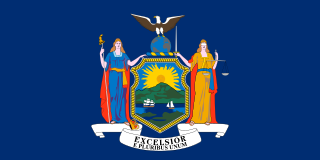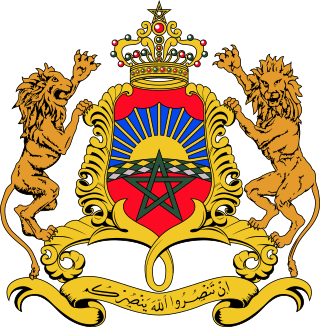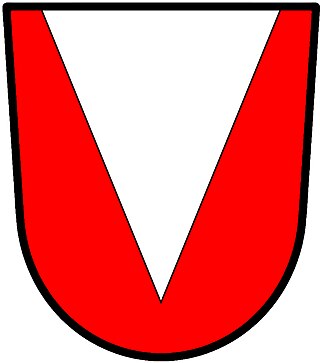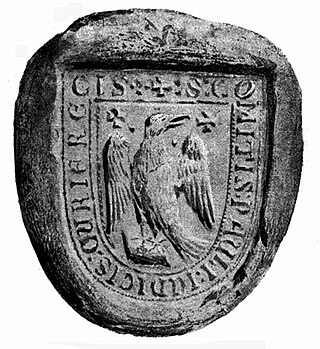
Heraldry is a discipline relating to the design, display and study of armorial bearings, as well as related disciplines, such as vexillology, together with the study of ceremony, rank and pedigree. Armory, the best-known branch of heraldry, concerns the design and transmission of the heraldic achievement. The achievement, or armorial bearings usually includes a coat of arms on a shield, helmet and crest, together with any accompanying devices, such as supporters, badges, heraldic banners and mottoes.

The coat of arms of the state of New York was formally adopted in 1778, and appears as a component of the state's flag and seal.
In heraldry, the field (background) of a shield can be divided into more than one area, or subdivision, of different tinctures, usually following the lines of one of the ordinaries and carrying its name. Shields may be divided this way for differencing or for purposes of marshalling, or simply for style. The lines that divide a shield may not always be straight, and there is a system of terminology for describing patterned lines, which is also shared with the heraldic ordinaries.
In heraldry, an ordinary is one of the two main types of charges, beside the mobile charges. An ordinary is a simple geometrical figure, bounded by straight lines and running from side to side or top to bottom of the shield. There are also some geometric charges known as subordinaries, which have been given lesser status by some heraldic writers, though most have been in use as long as the traditional ordinaries. Diminutives of ordinaries and some subordinaries are charges of the same shape, though thinner. Most of the ordinaries are theoretically said to occupy one-third of the shield; but this is rarely observed in practice, except when the ordinary is the only charge.
In heraldry, a charge is any emblem or device occupying the field of an escutcheon (shield). That may be a geometric design or a symbolic representation of a person, animal, plant, object, building, or other device. In French blazon, the ordinaries are called pièces, and other charges are called meubles.

The coat of arms of Spain represents Spain and the Spanish nation, including its national sovereignty and the country's form of government, a constitutional monarchy. It appears on the flag of Spain and it is used by the Government of Spain, the Cortes Generales, the Constitutional Court, the Supreme Court, and other state institutions. Its design consists of the arms of the medieval kingdoms that would unite to form Spain in the 15th century, the Royal Crown, the arms of the House of Bourbon, the Pillars of Hercules and the Spanish national motto: Plus Ultra. The monarch, the heir to the throne and some institutions like the Senate, the Council of State and the General Council of the Judiciary have their own variants of the coat of arms; thus the state coat of arms is not an arms of dominion.

Impalement is a heraldic practice in which two coats of arms are combined in one shield to denote a union. The impaled shield is bisected in pale, that is by a vertical line, with each half of the shield displaying one coat of arms. Most often the practice is used to denote the union of a husband and wife in marriage, but impalement is also used to display unions with an ecclesiastical office, academic position, government office, or mystical union.

Portuguese heraldry encompasses the modern and historic traditions of heraldry in Portugal and the Portuguese Empire. Portuguese heraldry is part of the larger Iberian tradition of heraldry, one of the major schools of heraldic tradition, and grants coats of arms to individuals, cities, Portuguese colonies, and other institutions. Heraldry has been practiced in Portugal at least since the 12th century, however it only became standardized and popularized in the 16th century, during the reign of King Manuel I of Portugal, who created the first heraldic ordinances in the country. Like in other Iberian heraldic traditions, the use of quartering and augmentations of honor is highly representative of Portuguese heraldry, but unlike in any other Iberian traditions, the use of heraldic crests is highly popular.

The coat of arms of Morocco is the arms of dominion of the King of Morocco. It was introduced on 14 August 1957.
In heraldry and heraldic vexillology, a blazon is a formal description of a coat of arms, flag or similar emblem, from which the reader can reconstruct the appropriate image. The verb to blazon means to create such a description. The visual depiction of a coat of arms or flag has traditionally had considerable latitude in design, but a verbal blazon specifies the essentially distinctive elements. A coat of arms or flag is therefore primarily defined not by a picture but rather by the wording of its blazon. Blazon is also the specialized language in which a blazon is written, and, as a verb, the act of writing such a description. Blazonry is the art, craft or practice of creating a blazon. The language employed in blazonry has its own vocabulary, grammar and syntax, which becomes essential for comprehension when blazoning a complex coat of arms.

Spiesheim is an Ortsgemeinde – a municipality belonging to a Verbandsgemeinde, a kind of collective municipality – in the Alzey-Worms district in Rhineland-Palatinate, Germany.

Charles V, Holy Roman Emperor was the heir of several of Europe's leading royal houses. In 1506, he inherited the Burgundian Netherlands, which came from his paternal grandmother, Mary of Burgundy. In 1516, Charles became the king of Spain, inheriting the kingdoms first united by his maternal grandparents, Isabella I of Castile and Ferdinand II of Aragon. Finally, on the death of his paternal grandfather in 1519, Maximilian I, Holy Roman Emperor, he inherited the Habsburg lands in central Europe and was elected Holy Roman Emperor.

In heraldry, a pile is a charge usually counted as one of the ordinaries. It consists of a wedge emerging from the upper edge of the shield and converging to a point near the base. If it touches the base, it is blazoned throughout.

The Coat of arms of the Prince of Spain was set out in the Spanish Decree 814 of 22 April 1971, by which the Rules for Flags, Standards, Guidons, Banners, and Badges were adopted.
Benedict, son of Korlát was a Hungarian nobleman, who served as voivode of Transylvania twice, from 1202 to 1206 and 1208 to 1209. He was styled as "dux" by royal charters – the first one who is not a relative of the royal Árpád dynasty –, which indicated his high social prestige. Due to the lack of sources and the presence of multiple barons named Benedict in the period simultaneously, there are a number of difficulties in drawing and defining his career path.

Paul Nagymartoni was an influential Hungarian nobleman and jurist in the first half of the 14th century, who served as Judge royal from 1328 to 1349.

The Nagymartoni or Martinsdorfi was a noble family in the Kingdom of Hungary of Aragonese origin, which existed from the early 13th century to the mid-15th century. In the last period of their existence, they were subjects of the Duke of Austria too.
Simon (I) Nagymartoni was an Aragonese-born Hungarian knight and diplomat in the first half of the 13th century. He and his siblings settled down in Hungary, where the family integrated into the social elite. Simon was a faithful confidant of kings Andrew II and Béla IV.
Bertrand Nagymartoni was an Aragonese-born Hungarian knight and nobleman in the 13th century. He and his siblings settled down in Hungary, where the family integrated into the social elite.

Simon (II) Nagymartoni was a Hungarian lord in the second half of the 13th century, who served as ispán of Bars County from 1277 to 1278.













